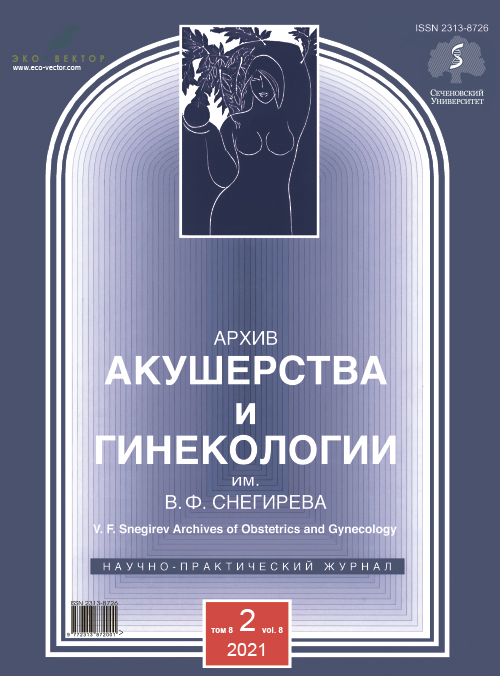Том 8, № 2 (2021)
- Год: 2021
- Выпуск опубликован: 01.06.2021
- Статей: 7
- URL: https://archivog.com/2313-8726/issue/view/3859
- DOI: https://doi.org/10.17816/aog.82
Научные обзоры
Синдром поликистозных яичников: отдалённые результаты хирургического лечения (обзор литературы)
Аннотация
Синдром поликистозных яичников (СПКЯ) ― довольно распространённое заболевание, занимающее одну из лидирующих позиций среди причин эндокринного бесплодия. У женщин с этим диагнозом повышен риск развития сахарного диабета, сердечно-сосудистых заболеваний, метаболического синдрома (дислипидемии, снижения чувствительности периферических тканей к инсулину, гиперинсулинемии). В настоящее время применяется поэтапный и индивидуальный подход к лечению, включающий как консервативные методы лечения, так и хирургические.
 61-66
61-66


Дифференциальная диагностика тромботической микроангиопатии в акушерстве: литературный обзор
Аннотация
Тромботическая микроангиопатия (ТМА) представляет собой клинико-морфологический синдром, в основе которого лежит повреждение эндотелия сосудов микроциркуляторного русла. Клинически ТМА характеризуется триадой симптомов: тромбоцитопенией, микроангиопатической гемолитической анемией и поражением органов-мишеней. В акушерской практике ТМА чаще всего встречается при преэклампсии или HELLP-синдроме, атипичном гемолитико-уремическом синдроме, тромботической тромбоцитопенической пурпуре. В обзоре приведены опорные дифференциальные критерии диагностики ТМА при беременности и после родов, а также тактика ведения пациентов.
 67-74
67-74


Методы прогнозирования перинатальных исходов в современном акушерстве
Аннотация
Проведён анализ работ, посвящённых исследованиям прогнозирования перинатальных исходов.
Цель этих исследований в акушерской науке и практике — снизить перинатальную заболеваемость и смертность. Стратегия эффективной оценки степени перинатального риска должна быть направлена на выбор рациональной тактики ведения беременности и родов, учитывая возможные осложнения для матери и плода. В настоящее время в мире применяются различные методы перинатальной диагностики, но невозможность точной оценки антенатального и интранатального состояния плода инструментальными методами актуализирует прогнозирование перинатальных исходов путём оценки степени перинатального риска.
 75-80
75-80


Применение стереоизомеров инозитола для терапии пациенток с клиническими и биохимическими признаками гиперандрогении
Аннотация
В течение последних лет клиническую и биохимическую гиперандрогению у пациенток с синдромом поликистозных яичников (СПКЯ) лечили с применением комбинированных оральных контрацептивов (КОК) с антиандрогенным действием. Вместе с тем необходимо создание альтернативной схемы терапии для пациенток, имеющих противопоказания к приёму гормональных препаратов, а также планирующим беременность. С этой целью активно ведётся изучение различных комбинаций стереоизомеров инозитола, а именно миоинозитола (МИ) и D-хироинозитола (ДХИ).
В обзоре отражены современные представления об этиологии и патогенезе гиперинсулинемии и андрогензависимых дерматологических проявлениях СПКЯ. Описаны механизмы действия инозитолов на молекулярном уровне, преимущества их использования для нормализации углеводного обмена в организме и снижения гиперинсулинемии, а также уровней мужских половых гормонов при СПКЯ. Проведён сравнительный анализ исследований, в которых применяли различные комбинации инозитолов, по эффективности лечения клинических проявлений гиперандрогении, таких как гирсутизм и акне. Использование МИ совместно с ДХИ снижает риск развития метаболического синдрома, улучшает эндокринный профиль и уменьшает проявления инсулинорезистентности, однако требуется проведение дальнейших многоцентровых исследований по этой проблеме.
 81-92
81-92


Оригинальные исследования
Преждевременный разрыв плодных оболочек при недоношенной беременности. Тактика ведения: реальность и перспективы
Аннотация
Преждевременный разрыв плодных оболочек (ПРПО) ― осложнение беременности, приводящее к преждевременным родам и рождению недоношенного ребёнка. Частота преждевременных родов колеблется в пределах 6–12%.
Материал и методы. На базе городской клинической больницы им. С.С. Юдина г. Москвы проведён ретроспективный анализ 71 истории родов пациенток с длительным безводным промежутком при недоношенной беременности и карт развития их новорождённых (за 2017–2020 гг.). Изучались перинатальные и материнские исходы родов, заболеваемость новорождённых и потребность в искусственной вентиляции лёгких (ИВЛ). Первую группу составили 19 пациенток со сроком гестации 22–28 нед., 2-ю группу ― 52 пациентки со сроком гестации 29–34 нед.
Результаты. Длительность безводного промежутка у пациенток 1-й группы (22–28 нед.) составила: до 48 ч ― 3 пациентки, 48 ч – 14 сут ― 15 пациенток, более 14 сут ― 1 пациентка. У пациенток 2-й группы (29–34 нед.) соответственно: до 48 ч ― 17 пациенток, 48 ч – 14 сут ― 30 пациенток, более 14 сут ― 5 пациенток. Продолжительность выжидательной тактики при ПРПО на недоношенном сроке беременности определялась сроком беременности, состоянием матери и плода, наличием клинико-лабораторных признаков хориоамнионита, количеством и динамикой объёма околоплодных вод. Тактика пролонгирования недоношенной беременности привела к значительному увеличению гестационного возраста на момент родов по сравнению с моментом госпитализации: в 1-й группе пациенток (22–28 нед. гестации) ― в среднем на 6,7 сут, максимальное увеличение составило 25 сут, во 2-й группе пациенток (29–34 нед. гестации) увеличение составило в среднем 6,8 сут, максимальное увеличение гестационного срока ― 35 сут.
Заключение. Анализ полученных данных позволил установить следующее. Применение выжидательной тактики ведения недоношенной беременности при ПРПО позволяет повысить гестационный возраст (в среднем на 6,8 сут), увеличить вес плода, снизить перинатальную смертность, уменьшить потребность недоношенных в ИВЛ более чем вдвое, обеспечить высокий уровень выписки новорождённых домой, перевод в отделения для новорождённых (на 2-й этап выхаживания).
 93-100
93-100


Влагалищная экстирпация матки с использованием имплантатов из титанового шёлка для профилактики рецидива заболевания
Аннотация
Введение. Частота постгистерэктомического пролапса купола влагалища достигает 43% у пациенток после хирургического лечения по поводу полного выпадения матки.
Цель работы ― повышение эффективности хирургического лечения с применением титановых сетчатых имплантатов у пациенток пре- и постменопаузального возраста с полным выпадением матки.
Материал и методы. В исследовании приняла участие 21 пациентка с полным выпадением матки, которым выполнен предложенный нами новый способ трансвагинальной хирургической профилактики постгистерэктомического пролапса купола влагалища. Оценивали результат оперативного лечения путём анализа данных влагалищного исследования и УЗИ.
Результаты. Наблюдали пациенток в течение 2 лет ― через 1, 6, 12 и 24 мес. Анализ данных влагалищного исследования и УЗИ показал отсутствие смещения купола влагалища, тазовых органов и деформации титановых имплантатов. Mesh-ассоциированных осложнений за время наблюдения не отмечено.
Заключение. Использование разработанного хирургического способа коррекции постгистерэктомического пролапса купола влагалища с применением имплантатов из титанового шёлка ― надёжное пособие, обеспечивающее высокую анатомическую эффективность у пациенток пре- и постменопаузального возраста.
 101-108
101-108


Клинические случаи
Клинический случай дифференциальной диагностики ретроцервикального эндометриоза
Аннотация
Эндометриоз ― хроническое гормонально-зависимое прогрессирующее заболевание, характеризующееся наличием эктопической эндометриоидной ткани. Чаще всего при эндометриозе поражаются яичники, маточные трубы и брюшная полость, однако эндометриоидные очаги обнаруживают и в кишечнике, сердце, лёгких, коже и в других атипичных локализациях. В данной статье описан клинический случай ретроцервикального эндометриоза, диагностированного по результатам патолого-гистологического исследования. Важно отметить сложности дифференциальной диагностики данной формы эндометриоза вследствие вторичных изменений участка толстой кишки и отсутствия характерных клинических проявлений.
 109-115
109-115












